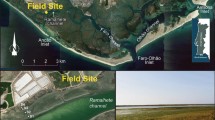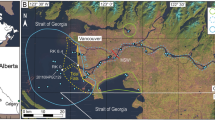Abstract
The threshold of sediment erosion by currents and waves (critical friction velocity, ) is an important predictive tool in sedimentology and coastal engineering1,2 owing to its use in entrainment and transport rate equations. The measurement of sediment transport is relevant to many concerns including dispersal of pollutants and dredge spoil, harbour and beach maintainence, geochemical fluxes and animal–sediment relations3. In marine sediments, biotic processes alter erosion criteria4, for instance through binding and stabilization of the sediment surface by the extracellular products of diatoms, bacteria and other benthic organisms5,6. Despite the widespread occurrence of benthic microbial mats and attendant sediment binding, prediction of erosion thresholds and transport rates in natural marine sediments has incorporated biotic variables only qualitatively5,7. We used a laboratory flume to erode intact sediment cores containing undisturbed mats of phototrophic purple sulphur bacteria. The pigment content of bacterial films (bacterio-chlorophyll a) was positively correlated with , increasing the erosion threshold as much as fivefold compared with sterile control cores. We demonstrate the profound influence of benthic micro-biota on prediction of erosion in marine sediments.
This is a preview of subscription content, access via your institution
Access options
Subscribe to this journal
Receive 51 print issues and online access
$199.00 per year
only $3.90 per issue
Buy this article
- Purchase on Springer Link
- Instant access to full article PDF
Prices may be subject to local taxes which are calculated during checkout
Similar content being viewed by others
References
1. Miller, M. C., McCave, I. N. & Komar, P. D. Sedimentology 24, 507-527 (1977). 2. Dyer, K. R. Coastal and Esluarine Sediment Dynamics (Wiley, Chichester, 1986). 3. McCave, I. N. The Benthic Boundary Layer (Plenum, New York, 1976). 4. Jumars, P. A. & Nowell, A. R. M. Com. Shelf Res. 3, 115-130 (1984). 5. Grant, J. in Tide Influenced Sedimentary Environments and Fades (eds de Boer, P. J., van Gelder, A. & Nio, S. D.) (Reidel, The Netherlands, in the press). 6. Grant, J., Bathmann, U. V. & Mills, E. L. Estuar. coast. Shelf Sci. 23, 225-238 (1986). 7. Rhoads, D. C. & Boyer, L. F. in Animal-Sediment Relations (eds McCall, P. L. & Tevesz, M. J. S.) 3-52 (Plenum, New York, 1982). 8. Cohen, Y., Castenholz, R. W. & Halvorson, H. O. Microbial Mats, Stromatolites (Liss, New York, 1984). 9. Triiper, H. G. & Pfennig, N. in The Procaryotes (eds Starr, M. P., Stolp, H., Truper, H. G., Balows, A. & Schlegel, H. G.) 229-312 (Springer, Berlin, 1981). 10. Hirsch, P. in Microbial Adhesion and Aggregation (ed. Marshall, K. C.) 373-394 (Springer, Berlin, 1984). 11. Jorgensen, B. B., Revsbech, N. P. & Cohen, Y. Limnol Oceanogr. 28, 1075-1093 (1983). 12. Neumann, A. C., Gebelein, C. D. & Scoffin, T. P. / sedim. Petrol. 40, 274-297 (1970). 13. Gust, G. & Weatherly, G. L. J. geophys. Res. 90, 4779-4792 (1985). 14. Kreplin, H. P. & Eckelmann, H. Phys. Fluids 22, 1233-1239 (1979). 15. van Gemerden, H. Arch. Mikrobiol. 64, 103-110 (1968). 16. Takahashi, M. & Ichimura, S. Limnol. Oceanogr. 15, 929-944 (1970). 17. Stal, L. J., van Gemerden, H. & Krumbein, W. E. FEMS Microbiol. Ecol. 31, 111-125 (1985). 18. Characklis, W. G. & Cooksey, K. E. Adv. appl. Microbiol. 29, 93-138 (1983). 19. Grant, J. & Bathmann, U. V. Science 236, 1472-1474 (1987). 20. Gallardo, V. A. Nature 268, 331-332 (1977).
Author information
Authors and Affiliations
Rights and permissions
About this article
Cite this article
Grant, J., Gust, G. Prediction of coastal sediment stability from photopigment content of mats of purple sulphur bacteria . Nature 330, 244–246 (1987). https://doi.org/10.1038/330244a0
Received:
Accepted:
Issue Date:
DOI: https://doi.org/10.1038/330244a0
This article is cited by
-
Biodiversity of the microbial mat of the Garga hot spring
BMC Evolutionary Biology (2017)
-
The pervasive role of biological cohesion in bedform development
Nature Communications (2015)
-
Microbial stabilization of sediments in a recent Salina, Lake Aghormi, Siwa Oasis, Egypt
Facies (2014)
-
Erosion of biofilm-bound fluvial sediments
Nature Geoscience (2013)
Comments
By submitting a comment you agree to abide by our Terms and Community Guidelines. If you find something abusive or that does not comply with our terms or guidelines please flag it as inappropriate.



